Volume. 1, July - September, 2012 - amam-ayurveda.org
Volume. 1, July - September, 2012 - amam-ayurveda.org
Volume. 1, July - September, 2012 - amam-ayurveda.org
Create successful ePaper yourself
Turn your PDF publications into a flip-book with our unique Google optimized e-Paper software.
polygonal in shape and filled with plenty of starch grains, simple, ovoid,<br />
or irregularly ovoid-elliptical, occasionally compound of 2-4 components,<br />
several secretory cells, found scattered in the cortex, pericyclic fibres<br />
lignified with wide lumen and pointed ends, associated with a large<br />
number of crystal fibres containing a single prism in each chamber,<br />
vascular zone composed of 10-12 or more wedge-shaped strips of xylem,<br />
externally surrounded by semi-circular strips of phloem, alternating, with<br />
wide medullary rays, phloem consists of sieve tube, companion cells and<br />
phloem parenchyma of polygonal or tangentially elongated cells, some<br />
of them contain cryste1s of calcium oxalate, cambium composed of one<br />
to two layers of tangentially elongated cells in each vascular bundle,<br />
xylem consists of vessels, tracheids, parenchyma and fibres, in primary<br />
xylem, vessels comparatively narrow devoid of tyloses, secondary xylem<br />
elements thick-walled, lignified, vessels cylindrical in shape bearing<br />
bordered pits on their walls some large vessels possess several tyloses and<br />
often contain transverse septa, meduallry rays 15-20 or more cells wide<br />
containing rounded,hemispherical, oblong, ovoid, with faintly marked<br />
concentric striations and central hilumappearing like a point, starch grains<br />
of 5.5-11.20 μ in diameter and 6-11.28 μ in length,pith composed of large,<br />
thin-walled cells mostly containing starch grains.<br />
IDENTITY, PURITY AND STRENGTH<br />
For dried drug:–<br />
Foreign matter - Not more than 2 per cent<br />
Total ash - Not more than 16 per cent,<br />
Acid-insoluble ash - Not more than 3 per cent,<br />
Acid-insoluble ash - Not more than 3 per cent,<br />
Alcohol-soluble extractive - Not less than 3 per cent,<br />
Water-soluble extractive - Not less than 11 per cent,<br />
For fresh drug:–<br />
Foreign matter - Nil<br />
Moisture content - 75 per cent<br />
CONSTITUENTS - Terpenoids and alkaloids.<br />
PROPERTIES AND ACTION<br />
Rasa: Tikta, Kashaya<br />
Guna: Laghu<br />
Virya: Ushna<br />
Vipaka: Madhura<br />
Karma: Tridoshashamaka, Samgrahi, Balya, Dipana, Rasayana,<br />
Raktashodhaka,<br />
Jvaraghna<br />
IMPORTANT FORMULATIONS - Amritarishta, Amritottara Kvatha<br />
Churna, Guduci Taila, Guduchyadi Churna, Guduchyadi Sattva,<br />
Chinnodbhavadi Kvatha Churna<br />
THERAPEUTIC USES - Kushtha, Vatarakta, Jvara, Kamala, Pandu,<br />
Prameha<br />
DOSE - 3-6 g of the drug in powder form.<br />
20-30 g of the drug for decoction.<br />
VIDANGA (Fruit)<br />
(API Part - I,<strong>Volume</strong> 1, Page 123)<br />
Info Ayurveda, <strong>Volume</strong> 2, No.1, <strong>July</strong> to <strong>September</strong>’ <strong>2012</strong><br />
Vidanga consists of dried mature fruits of Embelia ribes Burm. F. (Fam.<br />
Myrsinaceae), large scandent shrub with long slender, flexible branches,<br />
distributed throughout hilly parts of India upto 1600 m,<br />
SYNONYMS<br />
Sanskrit: Jantughna, Krimighna, Vella, Krimihara, Krimiripu<br />
Assamese: Vidang<br />
Bengali: Vidang<br />
Gujrati: Vavding, Vavading, Vayavadang<br />
Hindi: Vayavidanga, Bhabhiranga, Baberang<br />
Kannada: Vayuvilanga, Vayuvidanga<br />
Kashmiri: Babading<br />
Malayalam: Vizhalari, Vizalari<br />
Marathi: Vavading, Vavding<br />
Oriya: Bidanga, Vidanga<br />
Punjabi: Babrung, Vavaring<br />
Tamil: Vayuvilangam, Vayuvidangam<br />
Telugu : Vayuvidangalu<br />
Urdu : Baobarang, Babrang<br />
DESCRIPTION<br />
a) Macroscopic<br />
Fruit brownish-black, globular 2-4 mm in diameter, warty surface with<br />
a beak like projection at apex, often short, thin pedicel and persistant<br />
calyx with usual1y 3 or 5 sepals present, pericarp brittle enclosing a<br />
single seed covered by a thin membrane, entire seed, reddish and covered<br />
with yellowish spots (chitra tandula), odour slightly aromatic, taste,<br />
astringent.<br />
b) Microscopic<br />
Transverse section of fruit shows epicarp consisting of single row of<br />
tabular cells of epidermis, usually obliterated, in surface view cells<br />
rounded with wrinkled cuticle, mesocarp consists of a number of layers<br />
of reddish-brown coloured cells and numerous fibrovascular bundles and<br />
rarely a few prismatic crystals of calcium oxalate, inner part of mesocarp<br />
and endodennis composed of stone cells, endodermis consisting of single<br />
layered, thick-walled, large, palisade-like stone cells, seed coat composed<br />
of 2-3 layered reddish-brown coloured cells, endosperm cells irregular in<br />
shape, thick-walled, containing fixed oil and proteinous masses, embryo<br />
small when present otherwise most of the seeds sterile.<br />
Powder-Reddish, under microscope shows reddish parenchyma and stone<br />
cells.<br />
IDENTITY, PURITY AND STRENGTH<br />
Identification:-<br />
(I) Shake 1 g of the powdered seeds with 20ml of Solvent Ether for five<br />
minutes and filter. To a portion of the filtrate add 5 per cent v/v solution of<br />
Sodium Hydroxide; a deep violet colour is developed in the aqueous layer.<br />
To the other portion add 2 drops of Dilute Ammonia solution; a bluish<br />
violet precipitate is obtained.<br />
(II) Boil 5 g of the powdered seeds: with 25 ml alcohol and filter. Divide the<br />
deep red coloured filtrate into two portions. To one portion, add solution<br />
of lead Acetate, a dirty green precipitate is produced. To the other portion<br />
add solution of ferric chloride a reddish-brown precipitate is produced.<br />
IDENTITY, PURITY AND STRENGTH<br />
Foreign matter - Not more than 2 per cent,<br />
Total Ash - Not more than 6 per cent,<br />
Acid-insoluble ash - Not more than 1.5 per cent,<br />
Alcohol-soluble extractive - Not less than 10 per cent,<br />
Water-soluble extractive - Not less than 9 per cent,<br />
Assay:-Contains not less than 2 per cent w/w of embelin (limits 1.85 to<br />
2.15) when assayed as follows:-<br />
Weigh accurately about 10 g of powder (40 mesh) and transfer to a 500 ml<br />
glass stoppered flask Shake occasionally for thirty minutes with 150 ml<br />
9




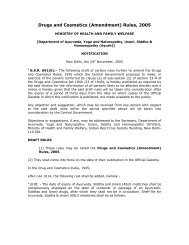
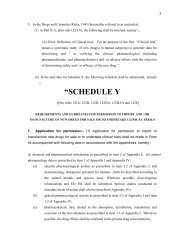
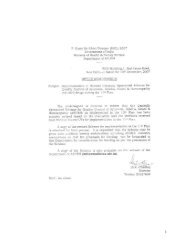

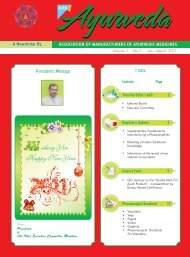

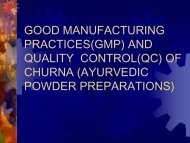
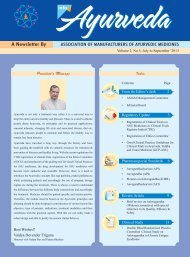
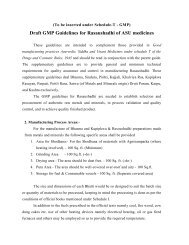
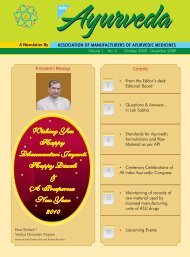
![[To be published in Gazette of India Part II Section 3, sub-section iii]](https://img.yumpu.com/28570283/1/190x245/to-be-published-in-gazette-of-india-part-ii-section-3-sub-section-iii.jpg?quality=85)

